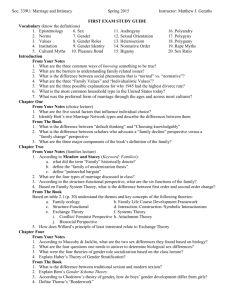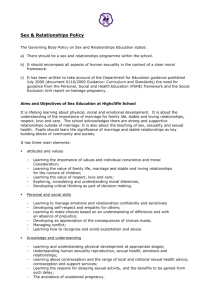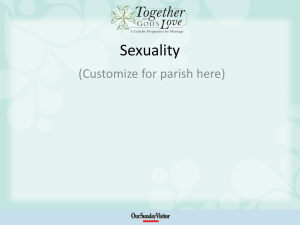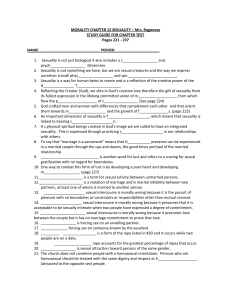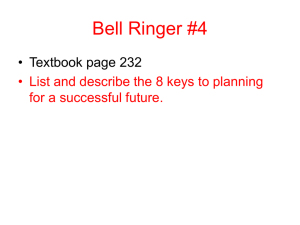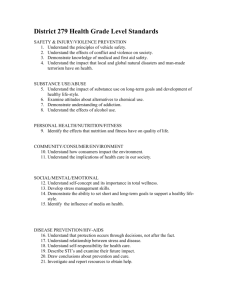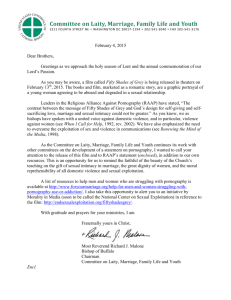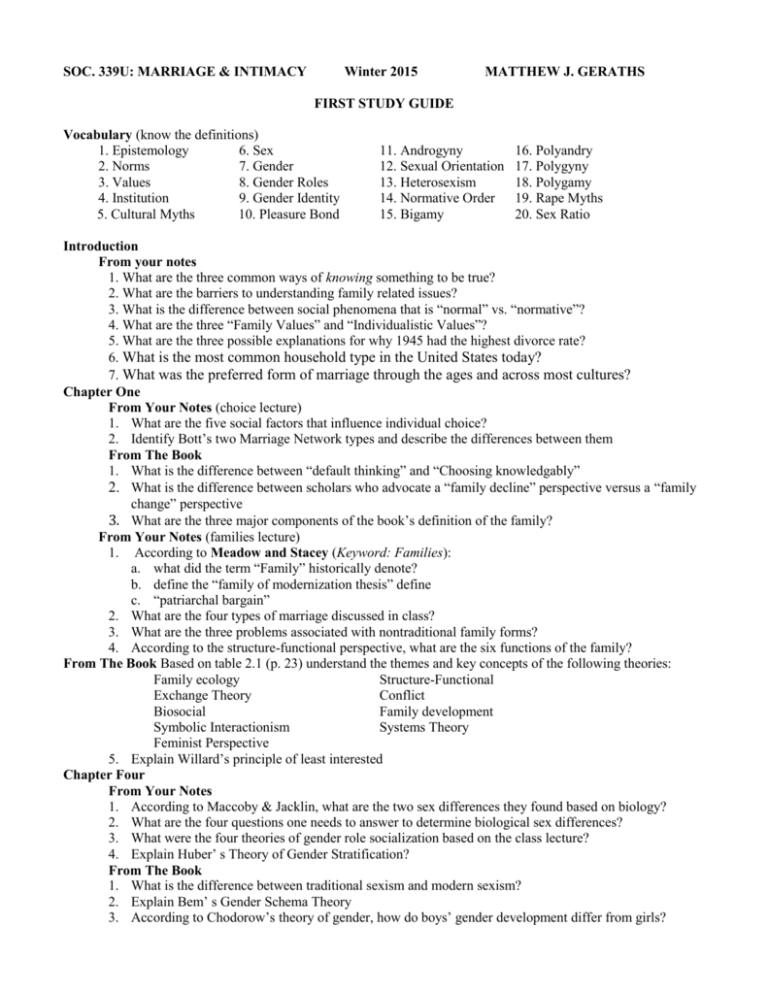
SOC. 339U: MARRIAGE & INTIMACY
Winter 2015
MATTHEW J. GERATHS
FIRST STUDY GUIDE
Vocabulary (know the definitions)
1. Epistemology
6. Sex
2. Norms
7. Gender
3. Values
8. Gender Roles
4. Institution
9. Gender Identity
5. Cultural Myths
10. Pleasure Bond
11. Androgyny
12. Sexual Orientation
13. Heterosexism
14. Normative Order
15. Bigamy
16. Polyandry
17. Polygyny
18. Polygamy
19. Rape Myths
20. Sex Ratio
Introduction
From your notes
1. What are the three common ways of knowing something to be true?
2. What are the barriers to understanding family related issues?
3. What is the difference between social phenomena that is “normal” vs. “normative”?
4. What are the three “Family Values” and “Individualistic Values”?
5. What are the three possible explanations for why 1945 had the highest divorce rate?
6. What is the most common household type in the United States today?
7. What was the preferred form of marriage through the ages and across most cultures?
Chapter One
From Your Notes (choice lecture)
1. What are the five social factors that influence individual choice?
2. Identify Bott’s two Marriage Network types and describe the differences between them
From The Book
1. What is the difference between “default thinking” and “Choosing knowledgably”
2. What is the difference between scholars who advocate a “family decline” perspective versus a “family
change” perspective
3. What are the three major components of the book’s definition of the family?
From Your Notes (families lecture)
1. According to Meadow and Stacey (Keyword: Families):
a. what did the term “Family” historically denote?
b. define the “family of modernization thesis” define
c. “patriarchal bargain”
2. What are the four types of marriage discussed in class?
3. What are the three problems associated with nontraditional family forms?
4. According to the structure-functional perspective, what are the six functions of the family?
From The Book Based on table 2.1 (p. 23) understand the themes and key concepts of the following theories:
Family ecology
Structure-Functional
Exchange Theory
Conflict
Biosocial
Family development
Symbolic Interactionism
Systems Theory
Feminist Perspective
5. Explain Willard’s principle of least interested
Chapter Four
From Your Notes
1. According to Maccoby & Jacklin, what are the two sex differences they found based on biology?
2. What are the four questions one needs to answer to determine biological sex differences?
3. What were the four theories of gender role socialization based on the class lecture?
4. Explain Huber’ s Theory of Gender Stratification?
From The Book
1. What is the difference between traditional sexism and modern sexism?
2. Explain Bem’ s Gender Schema Theory
3. According to Chodorow’s theory of gender, how do boys’ gender development differ from girls?
4. Define Thorne’ s “Borderwork”
5. What are Kimmel’s three types of men’s movements?
6. Explain Hyde’s Gender Similarity Hypothesis
Chapter Five
From Your Notes
1. Define an impersonal society and the paradox of love in such a society
2. What are four things love isn’t?
3. What are Crosby’s three types of relationships
4. How
does Schacter’ s
Labeling
Theory work?
5. Describe Goldstine & Weiner’s Stage Model of “How Love Progresses”
6. According to Davis and Todd, what differentiates a friendship from a love relationship?
7. Describe Stenberg’ s
theory of
love
stories
8. What are the three most popular and three least popular
From The Book
1. What are the three major components to your book’s definition of love?
2. What are Lee’s six types of love
3. Describe Reiss’ Wheel of Love Theory
4. What are the seven misconceptions of love from the book
5. Define intimacy—both components
6. Describe Crosby’ s Theory of Needs Satisfaction
7. What are the Six “Pillars” or practices of building self-worth
8. What are the three components of love in Stenberg’s Triangle Theory
a. In what order do they occur?
Chapter Six
From Your Notes
1. What are the four weaknesses of sex surveys?
2. What are the three components of sexuality discussed in lecture?
3. Explain the myth of dichotomous sexuality
4. What were the two biological explanations for homosexuality discussed in lecture?
5. Describe how each paradigm explains sexuality
a. Structural Functionalism
b. Biological Perspective
c. Interactionist Perspective
From The Book
1. What are the four components of Thibuat and Kelly’s “interpersonal exchange model of sexual
satisfaction”
2. Identify and discuss the different sexual scripts
3. Identify and discuss the five ways to negotiate heterosexual expression
4. Describe Sex as a Pleasure Bond

